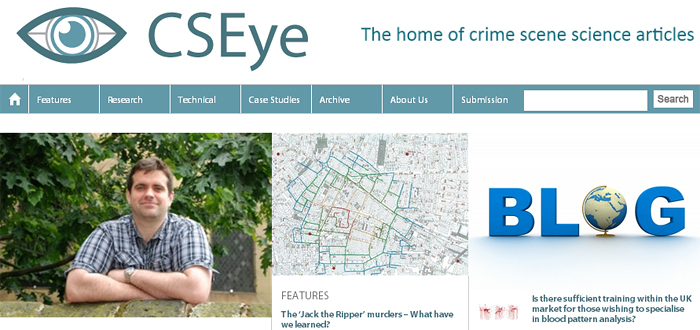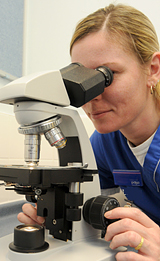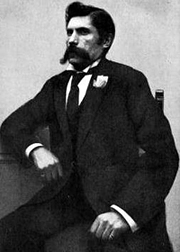Uni forensic scientist appointed new CSI journal Editor-in-Chief
 Dr Graham Williams is the inaugural editor of CS Eye, by the Chartered Society of Forensic Science, which covers cutting-edge developments in forensics
Dr Graham Williams is the inaugural editor of CS Eye, by the Chartered Society of Forensic Science, which covers cutting-edge developments in forensics
Thu, 01 May 2014 12:33:00 BST
Dr Graham Williams is appointed as the inaugural editor of CS Eye, the new online journal of the Chartered Society of Forensic Science
A NEW journal dealing with the latest breakthroughs in crime scene investigation is edited by a University of Huddersfield expert. And it reopens the most infamous cold case of all – the Jack the Ripper murders in Victorian London. A strong suspect is named, but there is massive regret that evidence was inadequately stored so that it cannot be fully reappraised by modern experts.
Dr Graham Williams is the inaugural editor of CS Eye, an online journal to be published every three months by the Chartered Society of Forensic Science (formerly the Forensic Science Society). It covers cutting-edge developments in forensics. The Whitechapel murder spree of 1888 by Jack the Ripper is the focus of an article in the first edition.
“It is one of the most famous of unsolved cases and we have an article looking at it from the perspective of modern crime scene investigation,” said Dr Williams. “If the Whitechapel Murders happened today, we would have caught Jack the Ripper very quickly!” says CS Eye editor Dr Williams.
CS Eye
Graham Williams is a Senior Lecturer in Forensic Science at the University of Huddersfield and has wide practical experience in the field. His major area of current research deals with forensic RNA analysis for body fluid identification.
 When the Chartered Society of Forensic Science – UK-based, but with many overseas members – decided to publish a new journal, he was selected for the editorship.
When the Chartered Society of Forensic Science – UK-based, but with many overseas members – decided to publish a new journal, he was selected for the editorship.
The journal – described as “the home of crime scene science articles” – is fully peer-reviewed, said Dr Williams. All articles are scrutinised by a board of experts from a wide range of backgrounds. They include current and retired crime scene investigators who have worked with various police services or as independent experts, alongside academics. One of the purposes of the new journal is to strengthen ties between university-based researchers and investigators working in the field.
In his inaugural editorial, Dr Williams writes: “The purpose of this journal is to highlight best practice and disseminate through to all our readers. This includes innovative research coming out of our universities, forensic science providers and other research institutes. In addition, technical notes evaluating new techniques and practices will be published along with interesting case studies.”
He adds that one of the main factors was the increasing role of the crime scene investigator in deciding what items to submit for analysis.
“In the past, the role of the crime scene investigator was to bag everything up and send it the lab. With this expansion of the roles and responsibilities of the crime scene investigator, it is important that they know what goes on in the lab and how this impacts upon their submission strategy. When this factor is considered, it becomes apparent that CS Eye needs to have a very wide remit indeed,” writes Dr Williams.
The Ripper Murders
 One of the feature articles in the inaugural issue concerns the famous Whitechapel Murders. The article’s author is former long-serving Metropolitan Police forensic expert Robert Milne (pictured left) – author of a major textbook – who examines the latest techniques that could be used in the case of the Ripper murders. He tells how he was influenced by the work of Professor David Canter, whose International Research Centre for Investigative Psychology (IRCIP ) is based at the University of Huddersfield.
One of the feature articles in the inaugural issue concerns the famous Whitechapel Murders. The article’s author is former long-serving Metropolitan Police forensic expert Robert Milne (pictured left) – author of a major textbook – who examines the latest techniques that could be used in the case of the Ripper murders. He tells how he was influenced by the work of Professor David Canter, whose International Research Centre for Investigative Psychology (IRCIP ) is based at the University of Huddersfield.
In his highly technical article, Mr Milne draws on research by Professor Canter and Dr Donna Youngs, who is Associate Director of the IRCIP. He examines the geography and environment of 1880s Whitechapel and conducts a detailed evaluation of the case, arguing that modern profiling techniques and a re-examination of key exhibits could still lead to fresh progress.
But Mr Milne regrets the “appalling gaffes ... made in not applying modern 20th Century onwards forensic science and working practices to the case, in times when more of the stored evidence was available”.
 “The carelessness by which no foresight was applied to retain the Ripper case evidence in test condition for future generations is in hindsight quite staggering. As late as the 1970s when a BBC team examined the evidence much of it was still available, but now alas it is missing or mislaid. The opportunities for an effective cold case review can definitely be said to have been squandered,” writes Mr Milne.
“The carelessness by which no foresight was applied to retain the Ripper case evidence in test condition for future generations is in hindsight quite staggering. As late as the 1970s when a BBC team examined the evidence much of it was still available, but now alas it is missing or mislaid. The opportunities for an effective cold case review can definitely be said to have been squandered,” writes Mr Milne.
Using geographical profiling methods, he concludes his article by drawing attention to a serial poisoner of women, George Chapman (pictured right), who was dwelling in the vicinity of the Ripper murders – 15 minutes away by tram. He was a suspected for the murder in 1902 of prostitute who was living in a house where two Ripper victims had lodged in the 1880s.
“The lack of foresight in not retaining the evidence even in cardboard boxes for future examination and review means we cannot now easily eliminate Chapman from that case or the other Whitechapel murders or any other suspect, but we can still learn more and more about the Whitechapel murders as our knowledge of forensic science and associated technologies continue to develop,” states Mr Milne.







